The Angelshark (Squatina Squatina) is an amazing shark species inhabiting the shallow coastal waters of the Mediterranean Sea and Eastern Atlantic. It is a bottom-dwelling species and can often be seen resting on the sand or muddy sea floor during daylight hours.
If you are here, I’m certain that you have numerous questions and concerns about the shark. Nonetheless, don’t worry – I will answer all of them in this article. So let us get started on our journey of discovery right away.
About: Angelshark (Squatina Squatina)
| Category | Information |
| Common Names | Angelshark |
| Scientific Name | Squatina squatina |
| Order | Squatiniformes |
| Family | Squatinidae |
| Diet | Fish, crustaceans, cephalopods |
| Habitat | Sandy or muddy bottoms, rocky reefs, seagrass beds |
| Distribution | Northeast Atlantic, Mediterranean Sea |
| Size | Up to 7.3 |
| Weight | Up to 77 lbs (35 kg) |
| Speed | Slow-moving, typically less than 1 meter per second |
| Life Expectancy | Up to 35 years |
| Reproduction | Aplacental Viviparity |
| Gestation Period | 8-10 months |
| Litter Size | 7-25 pups |
| Conservation Status | Critically Endangered |
The Angelshark, also known as Squatina Squatina, is a species of shark that belongs to the family Squatinidae. These sharks are mostly found in the eastern Atlantic Ocean and the Mediterranean Sea, although they have also been sighted in the North Sea and west Africa.
Angelsharks have a distinct flattened body that resembles a guitar, with two dorsal fins positioned towards the posterior end of their body.
These sharks are primarily bottom-dwelling, spending most of their time hidden beneath the sand or rocky crevices. They are opportunistic predators, feeding on a variety of prey, including bony fishes, crustaceans, and cephalopods.
Angelsharks are known to be slow-moving and docile, but they can quickly become aggressive if provoked or threatened.
Unfortunately, the Angelshark population has drastically declined over the past few decades due to overfishing and habitat destruction. They are listed as critically endangered by the International Union for Conservation of Nature (IUCN), with only a few hundred individuals remaining in the wild.
Conservation efforts are underway to protect this species, including habitat restoration and education initiatives to promote sustainable fishing practices.
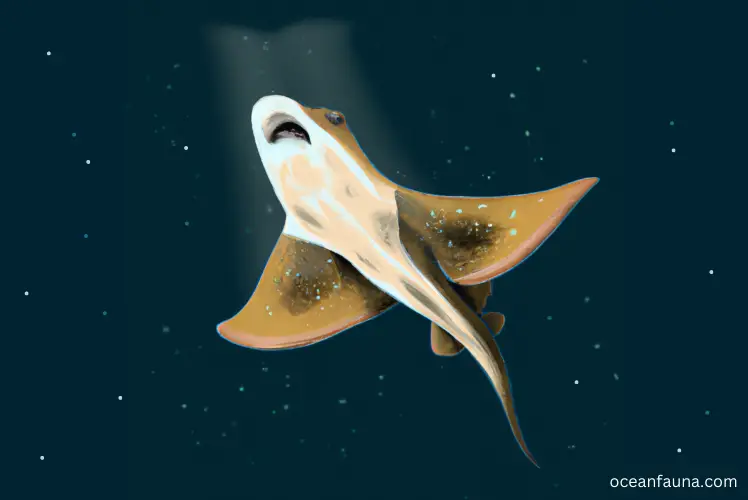
Why Is It Called an Angel Shark?
The angel shark got its name due to its unique appearance. The flattened pectoral fins around its head resemble wings or a halo, like an angel, hence the name “angel shark.”
Squatina, the genus to which angel sharks belong, has 19 different species that share this distinct feature. These sharks are often mistaken for rays due to their flattened appearance and ability to bury themselves in the sand.
However, they are, in fact, true sharks and are known for their ambush-hunting tactics. Angel sharks can be found in various oceans around the world, with some species being more widespread than others.
Interesting Facts about Angelsharks
1. Angelsharks have some other names – Monkfish, Angel Fish, Sand Devil, Fiddle Fish, and Sea Devil.
2. Angelsharks have flattened bodies and wingspan-like tails, making them look like rays – hence the name ‘angel.’
3. Angelsharks are camouflaged to blend in with the ocean floor and ambush their prey from below.
4. Angelsharks got their name from the flat and pointed head, which has prompted some people to compare them to angels.
5. They are found in shallow temperate waters of the Mediterranean Sea, the northeast Atlantic, and the Black Sea.
6. Angelsharks can live up to 35 years in the wild.
7. These sharks use their pectoral fins for locomotion, flapping them like wings to propel themselves through the water.
8. Angelsharks are considered a delicacy in some areas, and their meat is highly valued for its flavor.
9. Females have been known to reproduce up to 7-25 pups at a time – an impressive number for a shark species.
10. Angelsharks are currently classified as Critically Endangered by the IUCN Red List of Threatened Species.
Anatomy of Angelshark (Squatina Squatina)
Angelshark, also known as monkfish, fiddle fish, or sand devil, is a type of shark that belong to the family Squatinidae. They are known for their angelic and flattened appearance, making them look similar to rays.
The angelshark’s body is comprised of various organ systems, each with its unique function. In this article, we will discuss the different anatomical organ systems of an angelshark in detail.
Appearance And Body Color
Angelsharks are characterized by their flattened body and two large dorsal fins at the back. They typically have a grey-brown or beige coloration, with dark spots on the head and dorsal fins.
The underside of the angelshark is usually white in color and dotted with small black flecks.
Sensory Organs
The angelshark has several sensory organs that help it navigate its environment. These include the lateral line system, which helps detect vibrations in the water; ampullae of Lorenzini, which allows them to detect electrical fields in the water; and numerous other sensory organs.
They also have excellent vision, thanks to their eyes being located on the top of its head. This allows the angelshark to spot prey on the seafloor or lurking predators from above.
Mouth And Teeth
The angelshark’s mouth is located on the underside of its body, near the tip of its snout. They have small, sharp teeth that are designed to efficiently grip and tear their prey.
Skeletal System
The skeletal system of an angelshark is designed to support the body, protect the internal organs, and provide a framework for muscle attachment. Like all cartilaginous fish, its skeleton is made of cartilage.
The skull of an angelshark is particularly unique in that it has a flattened appearance, allowing them to bury itself in the sand fully. The rest of the skeleton is also flattened, making them particularly well adapted to a benthic lifestyle.
Muscular System
The muscular system of an angelshark is also adapted to allow for its benthic lifestyle. Their muscles are concentrated in their pectoral fins, which are used to “walk” along the ocean floor. These muscles are also used for propulsion when swimming in open water. Their caudal fin, or tail, is broad and flat, allowing them to maintain stability while resting on the floor.
Digestive System
The digestive system of an angel shark begins with its powerful jaws. Angelsharks are ambush predators, hiding under the sand and using their jaws to capture unsuspecting prey as it swims by. Their jaws are equipped with razor-sharp teeth arranged in rows, which are constantly being replaced as they wear down.
Once the prey is captured, it is swallowed whole, and the food moves through the esophagus into a two-chambered stomach. The first chamber grinds the food, and the second chamber further breaks it down with stomach acid. Their intestines then extract the necessary nutrients before excretion.
Circulatory System
The circulatory system of an angelshark involves a two-chambered heart, which pumps blood to the gills, where it is oxygenated. From there, the oxygen-rich blood flows back to the heart, where it is pumped to the rest of the body. Unlike most bony fish, angelsharks have five to seven pairs of gill slits on the sides of their heads instead of the usual five.
Nervous System
The nervous system of an angelshark is specialized for its hunting technique. Their sensory organs are highly evolved, able to detect minute electrical fields generated by their prey. They have tiny tubes on their head that function as organs of electroreception. These allow the shark to detect even hidden prey.
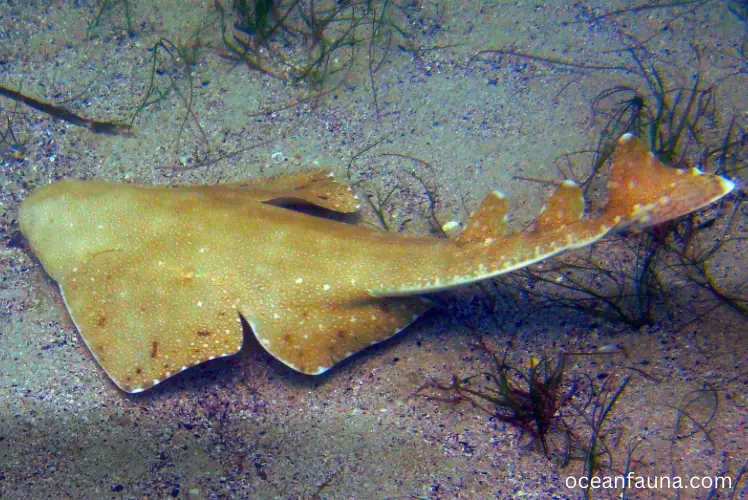
How Big Is an Angelshark?
The angelshark, scientifically known as Squatina squatina, is a relatively small shark species that are born at a length of 0.8 to 1 ft [24 to 30 cm]. As they grow older, females mature at sizes ranging from 4.1 to 5.5 ft [126 to 167 cm], while males reach a maximum length of 6 to 7.3 ft [183 to 224 cm].
These size ranges are just averages, and there can be significant variation depending on various factors such as the individual’s age, sex, and geographic location. In general, angelsharks in shallow waters tend to be smaller than those in deeper waters.
Despite their relatively small size, angelsharks are formidable predators in their habitat, using their flattened bodies and camouflaged appearance to ambush unsuspecting prey. They are known to feed on a wide variety of bony fish, crustaceans, and cephalopods.
When it comes to weight, adult angelsharks typically weigh around 77 pounds (35 kg). However, in exceptional cases, some individuals have been known to weigh over 130 pounds (60 kg). This weight variation is primarily due to the individual’s size and the availability of food sources in their environment.
What Do Angelsharks Eat?
Angelsharks (Squatina squatina) are known for their unique hunting technique, where they bury themselves in the sand and wait for their prey to come within striking range. They mainly feed on flatfishes, skates, crustaceans, and mollusks.
When hunting, the angel shark’s flattened body allows it to blend into the sand, making it nearly invisible to its prey. As soon as a potential meal is spotted, the angelshark will suddenly burst out of the sand and use its powerful jaws to grab hold of its prey.
Their diet primarily consists of bony fish, including sand eels, cod, and haddock. They also consume other demersal animals, such as skates, crustaceans, mollusks, and cephalopods.
It’s worth noting that angelsharks typically feed at night and are most active during the spring and summer months. Additionally, their diet and hunting techniques may vary depending on their location and the availability of prey in their environment.
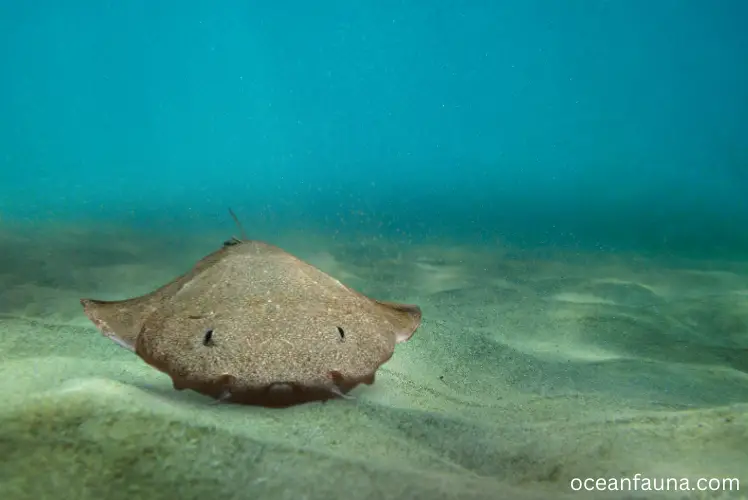
Where Do Angelsharks Live?
The angelshark, as mentioned above, prefers mud and sand bottoms inshore, particularly on coasts and estuaries. They can be found at depths of up to 16.4 ft [5 m] in these areas. However, they can also be found on the continental shelf, specifically at depths exceeding 492.1 [150 m].
In terms of distribution, the angelshark historically inhabited the Eastern Atlantic, ranging from Norway to Mauritania, including the Canary Islands, Mediterranean, and Black Sea. Unfortunately, they have since disappeared from some of these regions due to overfishing and habitat destruction.
Today, the remaining populations of angelsharks are primarily found in the Eastern Atlantic and Mediterranean Seas. They have also been reported off the coasts of Portugal, Morocco, Tunisia, and Israel. There is currently an effort to reintroduce angelsharks into their former habitats.
Are Angelsharks Dangerous To Humans?
Angel sharks typically present no threat to humans. Nonetheless, these predators have been known to bite SCUBA divers if disturbed or provoked. Therefore, swimmers must treat them with care, even though they can appear harmless and docile.
Angel sharks have a unique habit of staying still, which makes them easy to touch. Unfortunately, some divers have been known to grab them, which can provoke a response. These sharks may strike out in defense when threatened, but their bites are not usually severe.
In general, it is always advisable to maintain a safe distance from angel sharks when encountering them in their natural habitat. Though generally not hostile towards humans, give them the proper respect as wild animals.
By being cautious and respectful, divers can safely appreciate the grace of these incredible creatures in person.
How Long Does an Angelshark Live?
The lifespan of an Angelshark in the wild can range from 25 to 35 years. These amazing creatures can live up to three decades, making them a long-lived species in the marine world.
Angelsharks have evolved over time to adapt to their oceanic surroundings, and their longevity is one of their many impressive features.
They can be influenced by various factors, such as environmental conditions, predation risks, and human activities, which can all impact the lifespan of this species.
Nevertheless, these sharks are known for their resilience and impressive lifespan, making them important to marine biodiversity.
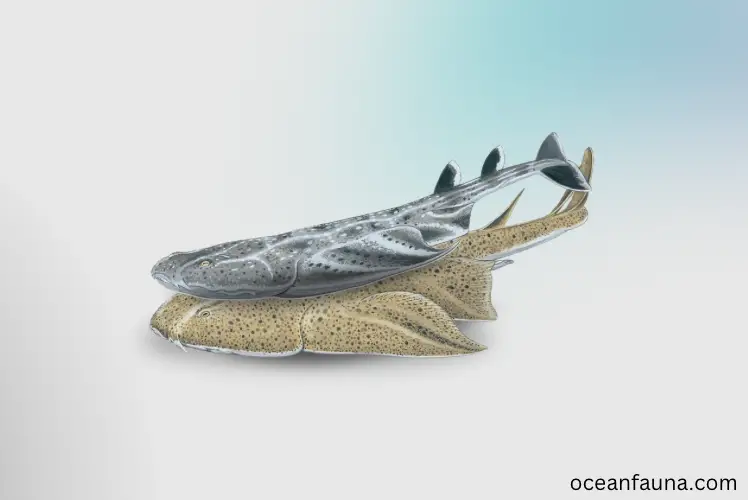
Reproduction And Lifescycle of Angel Shark
The angelshark, a species of shark, has a relatively short life cycle and reproduces through aplacental viviparity, which means that the embryos develop inside the female without a placenta.
The gestation period for these sharks takes between 8 and 10 months before females give birth to live young. During birth, females can give birth to a range of 7 to 25 pups at a time, which is quite an impressive number for a shark species.
Sadly, the angelshark has experienced a significant reduction in its range, with over 80% of its population disappearing in the past century. This drastic decline can be mainly attributed to commercial fishing activities that target these sharks for their meat, fins, and oil.
Additionally, the destruction of their habitats, such as shallow coastal areas and sandy sea bottoms, has contributed to their decline.
Despite their reduced population, angelsharks play an essential role in the marine ecosystem, and their decline can have significant consequences. These sharks act as predators, controlling the populations of smaller fish species and regulating the marine food web.
Therefore, protecting this species and their habitats and limiting commercial fishing activities are essential to ensure their survival.
What Is the Conservation Status of Angelsharks?
According to the assessment conducted in 2017 by The IUCN Red List of Threatened Species, the conservation status of the Angelshark (Squatina squatina) is listed as Critically Endangered under criteria A2bcd. This indicates that the species is facing an extremely high risk of extinction in the wild.
The Angelshark’s populations have drastically declined in recent years due to overfishing, habitat destruction, and bycatch in commercial fishing activities.
Angelsharks are particularly vulnerable to overfishing because of their slow rate of reproduction. Females give birth to an average of 10 pups every other year, compared to other shark species that can produce up to 50 pups per year.
Additional threats to Angelshark populations include unintentional entanglement in fishing nets, reduction of prey resources, and climate change impacts such as ocean acidification and rising temperatures.
To protect the Angelshark, various conservation initiatives are being undertaken. The species has been included in the Convention on the Conservation of Migratory Species of Wild Animals, which aims to protect and conserve migratory species and their habitats.
The European Union has also adopted measures to protect the Angelshark, including limiting fishing quotas and the development of fishing gear that reduces bycatch.
Efforts to restore their populations also include:
- Habitat restoration.
- Targeted marine protected areas.
- Monitoring programs to track population trends and better inform conservation efforts.
Conclusion
The angelshark is an important part of marine ecosystems, yet it is facing a serious threat from overfishing and habitat destruction.
Various conservation measures are being implemented to protect this species and ensure its long-term survival, such as limiting fishing quotas and creating marine protected areas. With concerted conservation efforts and public education, we can ensure that this majestic species will be around for generations to come.

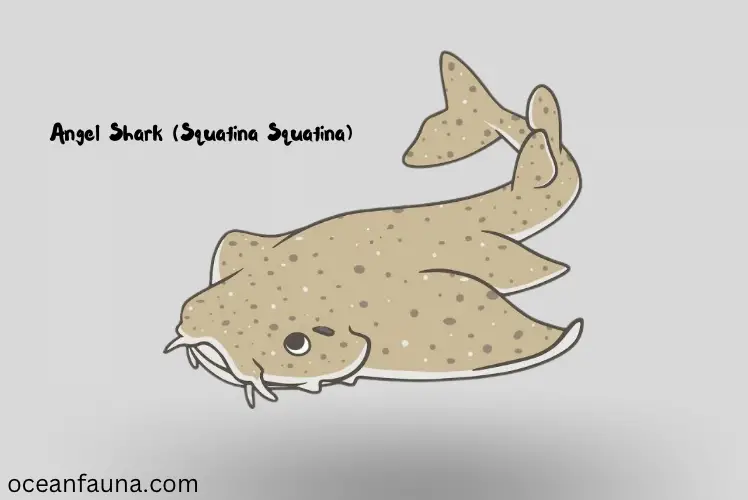
5 thoughts on “Angelshark (Squatina Squatina): Habitat, Diet, Anatomy & Facts”